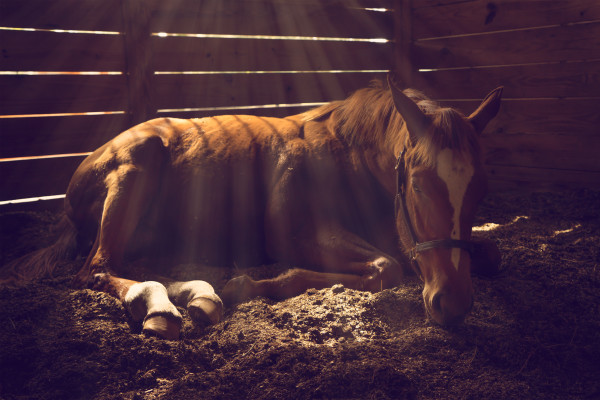Spring is gas colic season
- March 28, 2024
- ⎯ Equus
Listen here:
Colic can strike a horse at any time of year. But some types of gastrointestinal disturbances are more likely during certain seasons. In the springtime, gas is the usual culprit.
Gas colic develops when a horse ingests forage that is high in sugar—usually lush spring grass—and excessive fermentation occurs in the gut, which creates a buildup of gas. Horses cannot burp, but they can of course expel gas in the other direction. However, the length of the equine intestinal tract means that some gas pockets may not be able to escape. If the trapped gas continues to accumulate, the stretching of the intestinal wall may become painful.

The signs of gas colic may be transient, as the gas pockets shift. The horse may kick or nip at his flanks, repeatedly lie down and seem withdrawn and preoccupied. If you listen to his gut you may hear many gurgles (technically called borborygmi). Although gas colic may clear on its own, don’t take a wait-and-see approach. A gas-filled intestine can twist on itself, leading to a torsion that requires immediate surgery. Call your veterinarian at the first sign of colic.
Your veterinarian will first do a rectal exam to rule out blockages or displacements. The next step is typically to pass a nasogastric tube, which can be both a diagnostic test and a treatment. When the tube enters the stomach of a horse with gas colic, it provides an outlet for the gas to escape. Your veterinarian will smell the gas rushing out, and your horse may immediately look relieved as the pressure is eased. Often, this is all that is necessary to resolve the colic.
If your horse requires further treatment, your veterinarian may prescribe an anti-spasmodic drug such as Buscopan or a painkiller such as Banamine. Once comfortable and relaxed, most horses pass the gas and recover quickly. Still, it’s wise to be watchful for 24 hours to make sure there are no further troubles.
This article first appeared in EQUUS issue #452
Don’t miss out! With the free weekly EQUUS newsletter, you’ll get the latest horse health information delivered right to your in basket! If you’re not already receiving the EQUUS newsletter, click here to sign up. It’s *free*!





